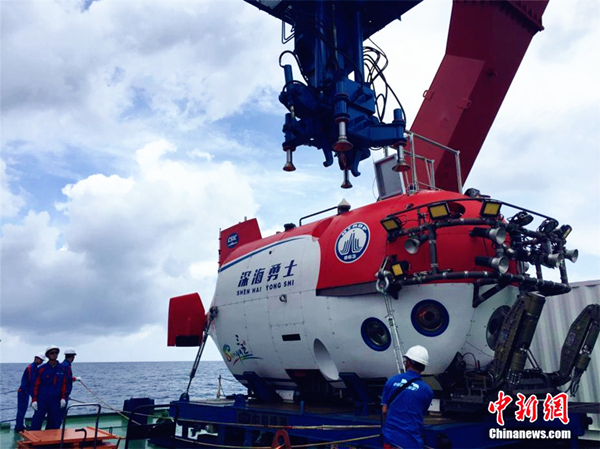
China's new manned submersible Shenhai Yongshi [Photo/Chinanews.com]
Archaeologists from the National Center of Underwater Cultural Heritage set out from Sanya in Hainan province to the north reef waters of the Xisha Islands on April 18 for China's first deep-sea archaeological survey.
According to the center's Deputy Director Song Jianzhong, the Shenhai Yongshi (Deep Sea Warrior) manned submersible will take six archaeologists to work in the area between six and eight hours per dive. The depth reached will be mainly from 50 m to 200 m. However, some dives may go to 1,000 m depending on operational need.
Team leader Ding Jianxiang said that China lacks experience in deep-sea archaeology at present and offshore activities mainly focus on neritic regions of less than 40 m. The depth of 300 m almost reaches the limit of human diving. This survey is the first trial and exploration of domestic archaeological deep-sea work.
Peng Xiaotong, chief scientist of the Institute of Deep-sea Science and Engineering of the Chinese Academy of Sciences (CAS), claimed that the biggest challenge of the task is whether the archaeologists have suitable psychological quality to work continuously for so long at such an unprecedented underwater depth. As it is the first time a manned deep submergence technology will be used in archaeology, the logistical support group will spare no effort to guarantee operational safety.
On the basis of the actual requirement of promoting domestic underwater archaeological development, the National Center of Underwater Cultural Heritage and the Institute of Deep-sea Science and Engineering of CAS signed a cooperation framework agreement in September last year and established a deep-sea archaeological laboratory this January.
Song Xinchao, deputy director general of the State Administration of Cultural Heritage, thought it was of great significance to integrate advanced technological means with underwater archaeology. He regards the survey as a solid foundation for further exploration of multi-field cooperation mechanism and protection of underwater cultural heritages.